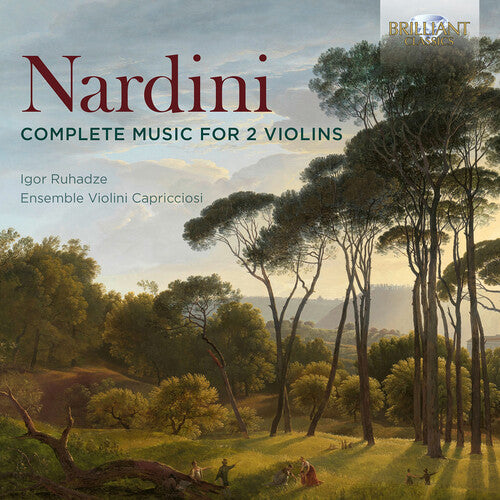Brilliant Classics
Nardini/ Ruhadze/ Gorban/ Ristori - Complete Music for 2 Violins
Nardini/ Ruhadze/ Gorban/ Ristori - Complete Music for 2 Violins
Usually ships within 1 to 2 weeks.
Couldn't load pickup availability
SKU:BRLT96873.2
Share
A feast of first recordings to celebrate the art of one of the greatest violinist-composers in 18th-century Europe. 'I have heard a certain Nardini, Leopold Mozart once wrote, 'and regarding beauty, purity, and equality of tone and in the singing taste nothing more beautiful can be heard.' The inveterate traveller and collector of culture Charles Burney was no less certain in his judgment of Nardini: 'he seems the completest player on the violin in all Italy; and, according to my feelings and judgment, his style is delicate, judicious, and highly finished.' We may judge for ourselves through the medium of his works, presented here in superbly stylish new recordings by a Dutch-based period ensemble with a track record of success in reviving lesser- known names from the golden age of the Baroque violin. Modern luminaries of the violin including Grumiaux, Milstein and Ricci used to perform Nardini's 'Sonata in D', and modern-Baroque virtuosos such as Giovanni Guglielmo and Giuseppe Carmignola have recorded his ornately wrought concertos, but this is the most comprehensive collection ever made of the composer's chamber-music output. To begin with, there are the Six Sonatas for two German Flutes or two Violins and a Bass, published in London in 1768. The Six duos pour deux violons, published in Paris around 1765, are very similar to the trio sonatas, but they feature typical violin idioms such as double stops and the use of lower notes than the flute would allow. The third of them brings a lively sequence of bird and animal sounds, from the cuckoo to the frog. The 14 New Italian Minuets for two Violins and a Bass, published in London around 1760, are short, unpretentious pieces, but skilfully composed and a joy to listen to. Born into a humble family in 18th-century Italy, Pietro Nardini's (1722-1793) talent for violin playing led him to Livorno to study with the celebrated Giuseppe Tartini, where he reportedly became as good a violinist as his teacher. He travelled throughout Europe and was resident musician at several of it's major courts - notably Tuscany, where he was Director of Music at the court of Grand Duke Leopold in Florence and worked there until his death. Such was his reputation as an extraordinarily expressive technician that he was asked to play in the presence of King Ferdinand IV and Queen Maria Carolina in Naples as well as Wolfgang and Leopold Mozart. Nardini left behind an extensive musical oeuvre, largely focused on the violin. All genres in which the violin plays an important role are represented in it. His style follows that of his time: melodious, uncomplicated and intended to be enjoyed by the listener. This new recording presents the complete works for two violins, with and without Basso Continuo, music of great charm, beauty and instrumental warmth. Igor Ruhadze's Brilliant Classics recording of sonatas by Locatelli (94736) won warm praise from Gramophone. 'The playing is elegantly supple, the string tone warm, and the architecture of individual movements thoughtfully worked out. All this makes for a pleasant mood and enjoyable listening. The more exuberant pieces are brilliantly and at times breathtakingly performed.' Fanfare extended an equally enthusiastic welcome to Ruhadze's album of concertos by Jean-Marie Leclair (95290): 'The playing... is really top-notch... The group's robust sound belies it's small numbers... it's hard to argue with playing as good as this.' On this recording he plays with Daria Gorban (baroque violin), Jacopo Ristori (baroque cello) and Alexander Puliaev (harpsichord).



